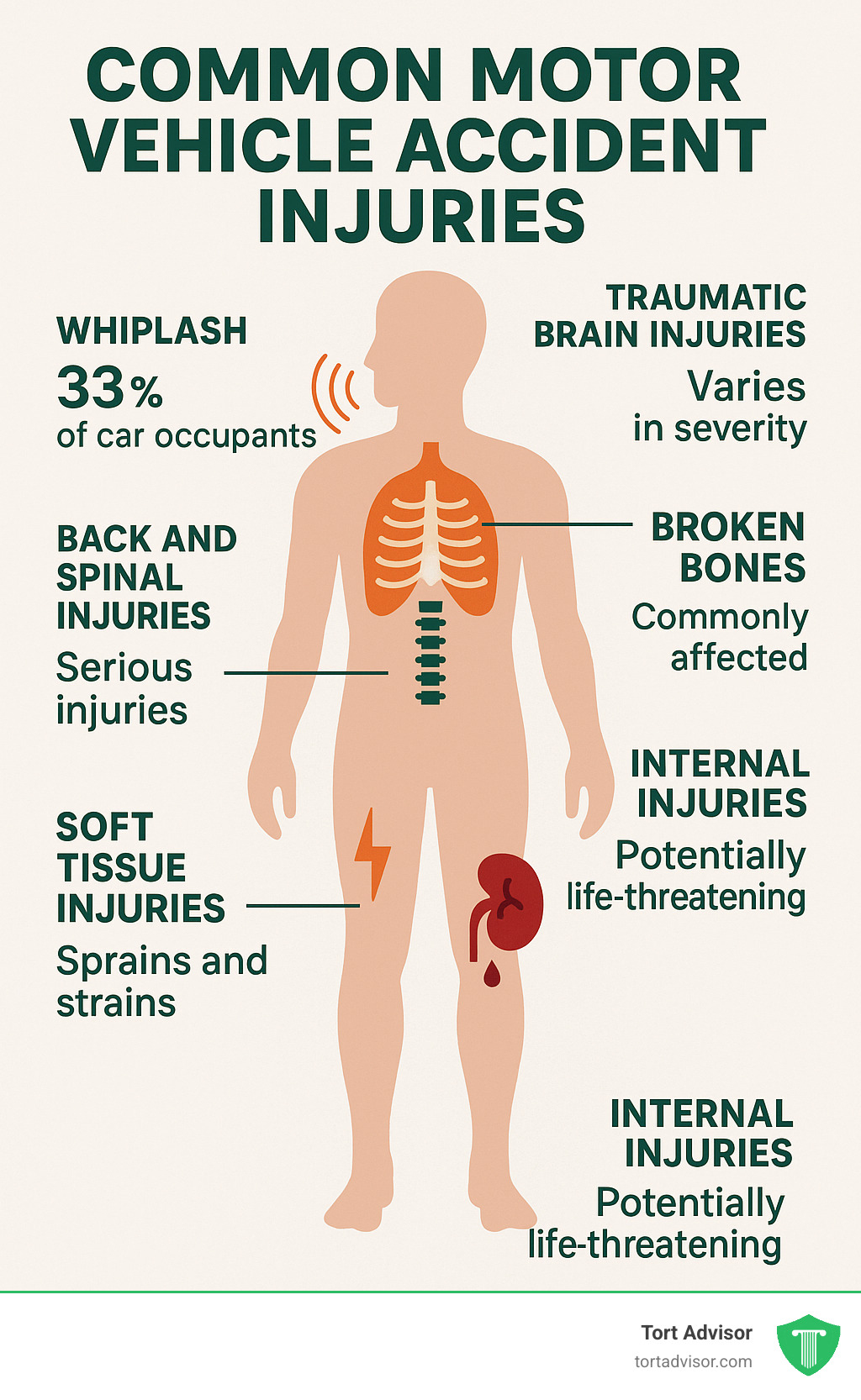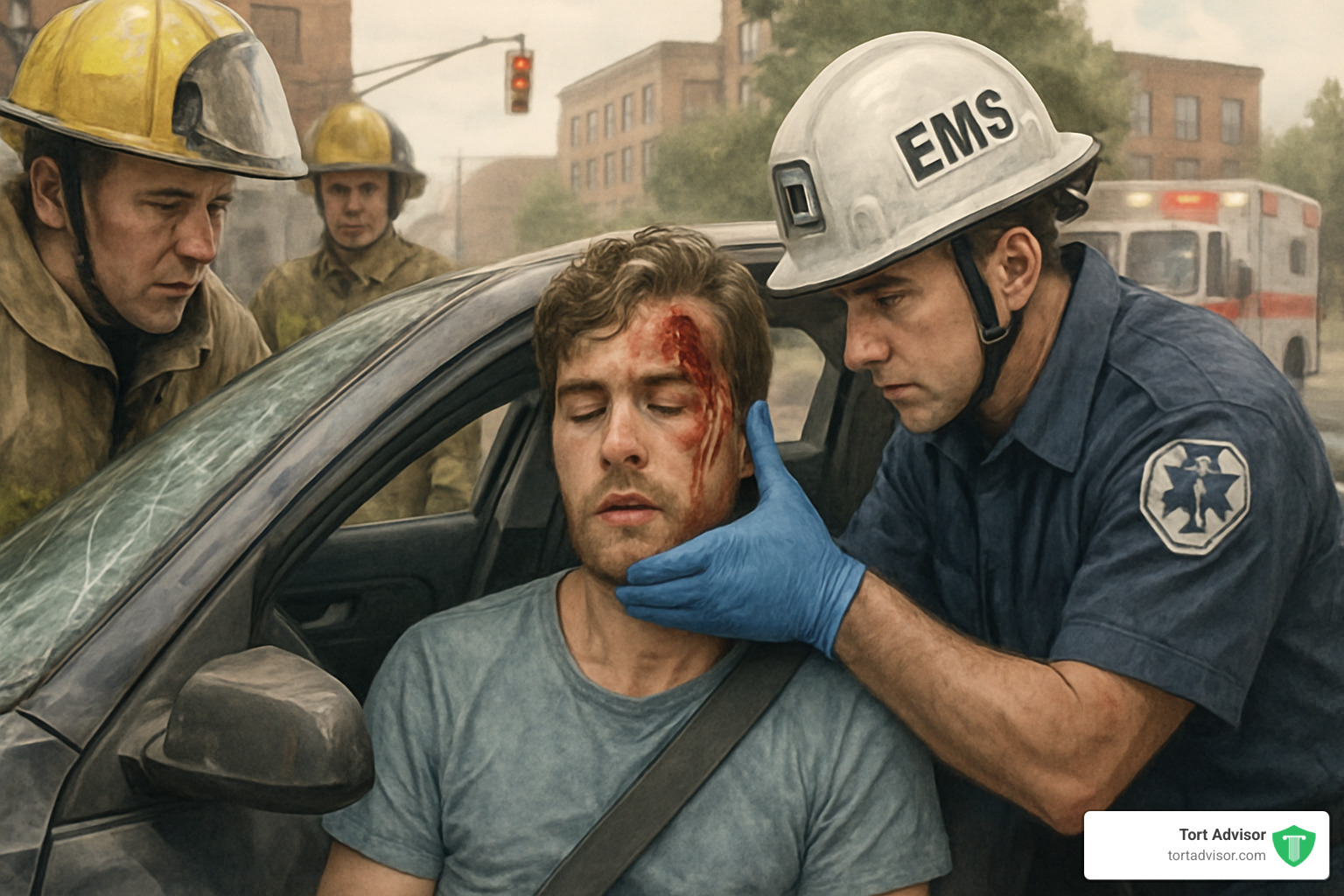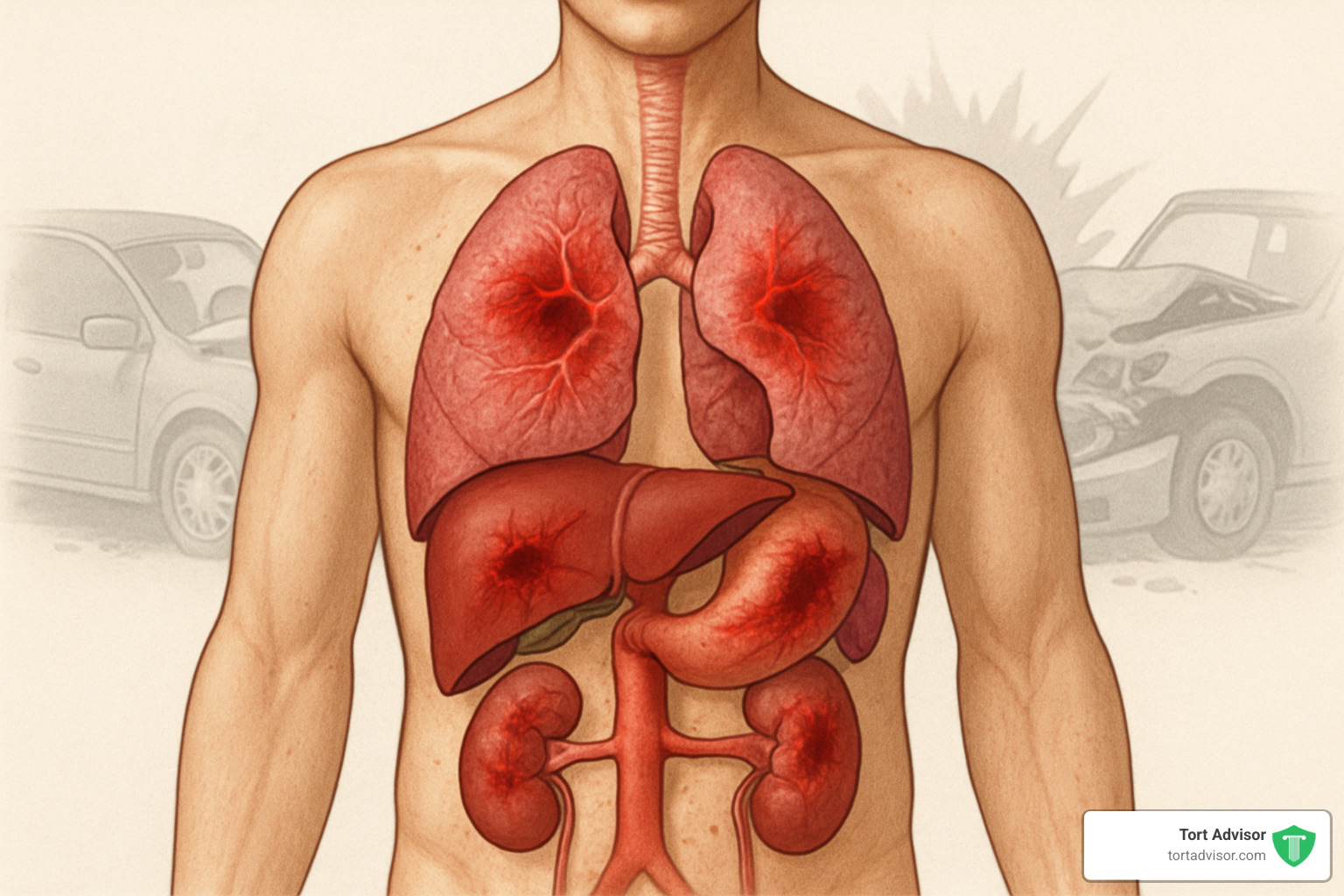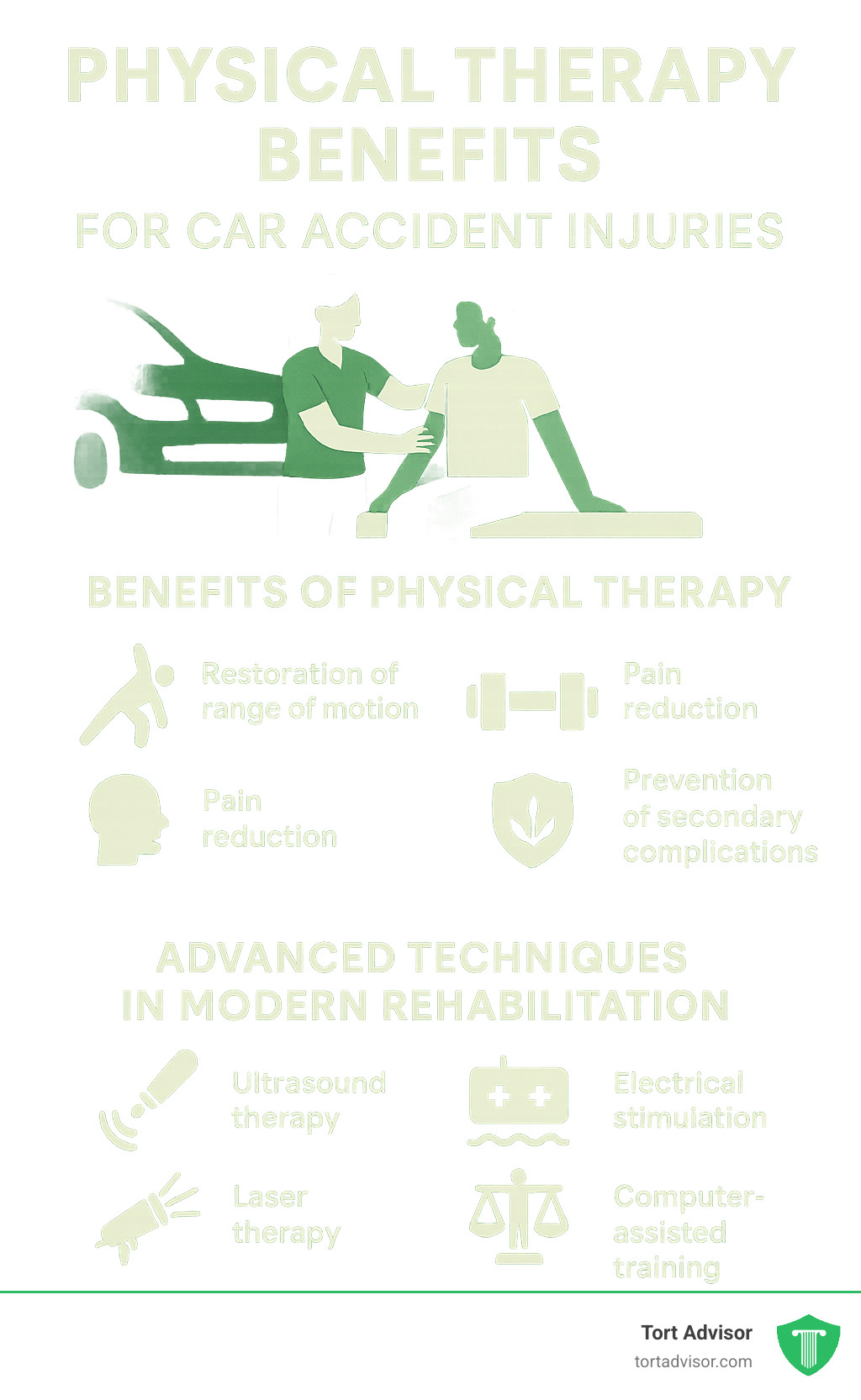


The Hidden Toll: Understanding Motor Vehicle Accident Injuries
Common motor vehicle accident injuries range from whiplash and concussions to fractures and internal organ damage. Here’s a quick overview of the most frequent injuries sustained in car crashes:
- Whiplash – Neck strain from sudden impact (affects 33% of car occupants)
- Traumatic Brain Injuries – Concussions and more severe brain trauma
- Back and Spinal Injuries – Herniated discs, fractures, and nerve damage
- Broken Bones – Particularly ribs, arms, legs, and collarbones
- Soft Tissue Injuries – Sprains, strains, and tears to muscles and ligaments
- Internal Injuries – Organ damage and internal bleeding
- Psychological Trauma – PTSD and anxiety following accidents
One second, you’re driving down a quiet street; the next, you’re staring at crumpled metal, hearing sirens, and feeling pain that wasn’t there a moment ago. This sudden shift is the reality for over 3 million Americans injured in motor vehicle accidents each year. What makes these injuries particularly challenging is that many don’t appear immediately – symptoms can develop hours or even days after the crash.
According to the National Highway Traffic Safety Administration (NHTSA), the most commonly injured body parts in collisions are the head, neck, back, and lower extremities. These injuries can range from minor bruising to life-altering trauma, with treatment costs averaging $820 per person annually across the U.S.
I’m Mason Arnao, and throughout my career helping accident victims steer recovery systems, I’ve seen how common motor vehicle accident injuries can disrupt lives both physically and financially, which is why understanding your rights after an accident is crucial for proper compensation and care.
Top 10 Common Motor Vehicle Accident Injuries (From Whiplash to Fractures)
When vehicles collide, our bodies absorb forces they weren’t built to handle. At Tort Advisor, we’ve helped countless clients find attorneys who specialize in these common motor vehicle accident injuries. Understanding what you might be facing can help you recognize symptoms and get proper treatment after a crash.
Whiplash – The Neck’s #1 Enemy in Crashes
Whiplash happens when your head snaps backward then forward like the cracking of a whip. This sudden movement strains the soft tissues in your neck, creating cervical acceleration-deceleration syndrome.
The tricky thing about whiplash is how sneaky it can be. You might walk away feeling fine, only to wake up the next morning barely able to turn your head. Symptoms typically include neck pain and stiffness, headaches starting at the base of your skull, limited neck movement, and sometimes dizziness.
Whiplash can happen at speeds as low as 15 mph. About 33% of car accident victims treated in emergency rooms are diagnosed with whiplash, making it the most common car crash injury. While most recover within a few weeks, roughly a quarter develop chronic neck pain that can last for years.
Scientific research on whiplash shows that if you’ve had whiplash before or you’re older, you might have a harder time recovering.
Head & Brain Trauma (Concussions and TBIs)
When your head hits something or gets violently shaken, your brain can bounce against the inside of your skull, causing bruising, bleeding, or torn nerve fibers.
Traumatic brain injuries (TBIs) exist on a spectrum from mild concussions to severe trauma. About 50,000 Americans die from TBIs annually, with car accidents causing nearly a quarter of all TBI hospitalizations.
Doctors use the Glasgow Coma Scale to measure brain injury severity. What makes brain injuries particularly dangerous is their invisibility – you can look perfectly fine while dealing with serious brain trauma.
Emergency rooms sometimes miss mild TBIs because they don’t always show up on standard CT scans. Watch for persistent headaches, confusion, memory problems, and sleep disturbances after an accident.
Scientific research on traumatic brain injuries shows that even “mild” concussions can cause lasting damage without proper treatment.
Spinal Cord & Back Injuries
Your spine takes a real beating in car accidents, especially in rollovers. Back injuries range from muscle strains that heal in weeks to catastrophic spinal cord damage causing permanent paralysis.
The most common spine injuries include herniated discs (when the cushioning material between vertebrae pushes out), spinal fractures (broken vertebrae), spinal cord injuries (damage to the nerve bundle itself), and facet joint injuries (damage to the small stabilizing joints).
Our research shows that the lower limbs (30%), upper limbs (19.4%), and neck (18.7%) suffer the most injuries in car accidents. About half of people with accident-related back injuries still report pain five years later.
Treatment options vary widely based on severity – from rest and physical therapy for minor strains to complex surgeries like spinal fusion for severe cases.
Bone Fractures and Dislocations
The crushing forces in a collision can snap bones like twigs. Fractures happen most often in high-speed crashes and side impacts.
The bones most commonly broken include ribs (often from seatbelt forces or airbags), collarbones (vulnerable due to their location), arms and wrists (when we instinctively brace for impact), and legs and ankles (particularly in front-end collisions).
Many arm and wrist fractures happen because of our natural instinct to brace for impact. While seatbelts can sometimes cause rib fractures in high-force collisions, that’s a small price to pay for the life-saving protection they provide.
Recovery typically involves immobilization followed by physical therapy. Simple fractures might heal in weeks, while complex breaks requiring surgical plates and screws can take months.
Soft-Tissue Sprains, Strains & Contusions
Soft tissue injuries – damage to muscles, ligaments, and tendons – can cause significant pain despite being invisible on standard imaging.
These injuries include sprains (stretched or torn ligaments), strains (damaged muscles or tendons), and contusions (bruising from blunt force).
Insurance companies often dismiss these as “just sprains” despite the significant pain they cause. Healing follows three phases: acute inflammation (first 3 days), repair (days 3-21), and remodeling (21 days to 12 months).
Treatment typically follows the RICE protocol (Rest, Ice, Compression, Elevation) before gradually rebuilding strength with physical therapy.
Internal Injuries & Organ Damage
The most frightening common motor vehicle accident injuries are often those you can’t see: internal injuries and organ damage.
Internal injuries include pneumothorax (collapsed lung, often from broken ribs), ruptured spleen (causing severe internal bleeding), liver lacerations (especially in side impacts), and aortic rupture (a tear in the main artery that’s often fatal).
What makes internal bleeding so dangerous is how it can progress rapidly without obvious external signs. Watch for warning signs like abdominal pain or swelling, dizziness, fainting, and unusual bruising.
About 3% of crash victims suffer some form of internal injury, and these almost always require immediate medical intervention, often including emergency surgery.
Psychological Injuries: PTSD, Anxiety & Depression
Post-Traumatic Stress Disorder affects many accident survivors, with symptoms including flashbacks of the crash, nightmares, avoidance of driving, jumpiness, and persistent anxiety. These symptoms typically develop over about three months following the traumatic event.
Beyond PTSD, many accident victims develop anxiety disorders, depression, or driving phobias. These conditions can dramatically impact your quality of life and ability to work, yet insurance companies frequently dismiss them as “not real injuries.”
At Tort Advisor, we connect people with attorneys who understand how to properly document and value these invisible but very real injuries.
How Collision Type and Safety Factors Shape Injury Patterns
The way a crash happens isn’t just random chaos—it follows patterns that directly affect what injuries you might suffer. As I’ve worked with accident victims over the years, I’ve noticed how predictable these injury patterns can be based on whether you were hit from behind, the side, or head-on.
Overview of Common Motor Vehicle Accident Injuries by Crash Type
In frontal collisions, your body typically moves forward suddenly, causing your head to strike the steering wheel or windshield, your chest to impact the steering wheel, and your knees to hit the dashboard. These crashes often result in facial lacerations, chest contusions, and broken kneecaps.
With rear-end collisions, your body experiences that classic back-then-forward motion that makes whiplash so common—occurring in over 85% of these crashes. Your neck takes the brunt of this force, but many people also suffer concussions when their head bounces off the headrest.
Side-impact crashes (often called T-bones) are particularly dangerous because there’s less vehicle structure to absorb the impact. If you’re sitting on the side that gets hit, you’re likely to suffer injuries to your head from hitting the window, chest and abdominal trauma from the door caving in, and potentially serious hip fractures.
Rollover accidents create complex injury patterns because your body gets tossed around, hitting multiple surfaces. These crashes often lead to spinal fractures, traumatic brain injuries from repeated head impacts, and crush injuries if the roof collapses.
According to the National Safety Council, T-bone collisions cause the most fatalities, while rear-enders account for over 40% of all injuries. Modern safety features make a huge difference in these patterns. A properly adjusted headrest can reduce your whiplash risk by 5-10%, while side-impact airbags cut severe chest injuries by about 25%.
Seat Position, Age & Road User Differences
Where you sit in the car—and who you are—dramatically changes your injury risk profile.
Drivers tend to get hurt differently than passengers. If you’re behind the wheel, you’re more likely to suffer injuries related to the steering wheel—chest contusions, rib fractures, and facial injuries if the airbag doesn’t deploy properly.
Front seat passengers often have more severe dashboard and windshield injuries since they don’t have a steering wheel to brace against.
Back seat passengers have a higher risk of traumatic brain injuries but a lower risk of chest injuries. This is partly because rear seats often have less advanced restraint systems than front seats.
Your age matters tremendously in how your body responds to a crash. Children under 12 face unique risks, which is why they need appropriate car seats or boosters. Elderly occupants (65+) have a fatality risk 2-3 times higher than younger adults, mainly because their bodies are more fragile.
Different types of road users face vastly different injury patterns. Motorcyclists account for 42% of injury cases despite being a smaller percentage of road users. Pedestrians account for 24% of cases. Helmet use is the single most important safety factor for motorcyclists, reducing fatality risk by 37% and severe head injury risk by 69%.
For those inside vehicles, seat belt use remains the most crucial safety decision you can make, reducing fatal injuries by 45-60%. It’s simple physics—being secured in place is always safer than becoming a human projectile during a collision.
From ER to Rehab: Diagnosing & Treating Crash Injuries
The journey from crash scene to recovery isn’t just a medical process—it’s a human one, filled with uncertainty, pain, and eventually, healing. I’ve guided many clients through this path, and understanding what lies ahead can make all the difference.
After the chaos of an accident settles, medical professionals become your first allies. Even if you feel perfectly fine (and many people do, thanks to adrenaline), getting checked out is crucial because many common motor vehicle accident injuries don’t show symptoms right away.
Emergency physicians have a toolkit of diagnostic methods they’ll use to assess your condition. They’ll start with a physical examination, looking for visible injuries and testing your responses. For a deeper look, they might order CT scans, which are particularly good at spotting fractures, internal bleeding, or brain injuries. MRIs provide more detailed images of soft tissues and the spinal cord, while traditional X-rays help identify bone injuries.
Some symptoms should send you straight to the ER without delay. These emergency red flags include losing consciousness (even briefly), developing a severe headache, vomiting, experiencing seizures, feeling confused, having unequal pupil sizes, noticing weakness or numbness in your limbs, struggling to breathe, seeing obvious deformities in your limbs, or feeling abdominal pain or swelling.
For about 10-15% of seriously injured accident victims, surgery becomes necessary. This might involve repairing fractures with hardware like plates and screws, stabilizing the spine, performing a craniotomy for brain injuries, or fixing damaged internal organs.
The Recovery Roadmap After Common Motor Vehicle Accident Injuries
Recovery isn’t a sprint—it’s more like a marathon with distinct phases, each building on the last. While everyone’s journey is unique, most follow a predictable pattern:
During the acute phase (the first week), the focus is on rest and immobilization as needed. Your medical team will work on managing your pain while developing a treatment plan custom to your specific injuries.
As you transition to the sub-acute phase (weeks 1-6), you’ll begin gradual mobilization under medical guidance. This is typically when physical therapy starts, and you’ll have follow-up imaging to check how you’re healing.
The rehabilitation phase (weeks 6-12+) brings progressive strengthening and conditioning exercises. You’ll work on improving your range of motion and relearning functional movements for daily activities.
How long will your recovery take? It largely depends on what you’re healing from:
- Mild whiplash typically resolves in 1-3 months
- Simple fractures generally heal in 6-12 weeks
- Mild traumatic brain injuries usually improve over 3 months to a year
- Moderate to severe TBIs can require 2+ years of recovery
- Spinal cord injuries often involve lifelong adaptation
The Role of Physical Therapy & Rehab Technologies
Physical therapy isn’t just an optional add-on to medical care—it’s often the backbone of recovery from common motor vehicle accident injuries. At Tort Advisor, we’ve witnessed countless clients transform through proper rehabilitation, often achieving better outcomes than they initially thought possible.
Good physical therapy offers multiple benefits: it restores your range of motion and flexibility, strengthens both injured and supporting muscles, reduces pain by teaching proper movement patterns, and prevents secondary complications.
Today’s rehabilitation approaches use impressive technology alongside hands-on care. Therapists might employ ultrasound therapy to promote deep tissue healing, electrical stimulation to manage pain and activate muscles, and specialized equipment for progressive strengthening.
What surprises many accident victims is that physical therapy can be as effective as surgery for many auto injuries. It helps patients avoid long-term opioid use while allowing them to actively participate in their healing.
Your Rights & Compensation After a Crash
When you’re dealing with common motor vehicle accident injuries, understanding your legal rights isn’t just helpful—it’s essential. The physical pain of recovery is challenging enough without adding financial stress to the mix. At Tort Advisor, we’ve seen how proper compensation can make all the difference in a victim’s recovery journey.
Medical records tell your injury story in a language insurance companies and courts understand. Every doctor visit, treatment plan, and therapy session creates a paper trail that validates your experience. These documents aren’t just for your medical team—they’re powerful evidence for your legal case.
Compensation for car accident injuries typically falls into two main categories. Economic damages cover the concrete costs: your medical bills (both current and future), lost wages when you can’t work, property damage to your vehicle, and any out-of-pocket expenses related to your injury.
Non-economic damages address the human side of your suffering—the pain that keeps you up at night, the emotional distress that follows trauma, the activities you can no longer enjoy, and the strain on your personal relationships (legally called “loss of consortium”).
In cases where someone’s behavior was particularly reckless or intentional, courts may also award punitive damages. These aren’t meant to compensate you directly but rather to punish truly egregious conduct and deter others from similar behavior.
What surprises many accident victims is how quickly insurance companies reach out with settlement offers—often before you’ve even had a chance to understand the full extent of your injuries. These early offers might seem helpful, but they’re typically designed to close your case inexpensively before all your damages are known.
At Tort Advisor, we’ve built a network of attorneys who understand both the medical and legal aspects of accident cases. They know how to properly value your claim and fight for the compensation you truly deserve, not just what an insurance algorithm calculates.
More info about a Motor Vehicle Accident attorney
Building a Strong Personal Injury Claim for Common Motor Vehicle Accident Injuries
Time is both your friend and enemy after an accident. While you need time to understand your injuries fully, every state has a strict deadline—called a statute of limitations—for filing personal injury claims. These typically range from 1-3 years after the accident, and missing this window can permanently bar you from seeking compensation.
The strongest claims are built on thorough documentation. Photos of visible injuries, a daily journal tracking your pain and limitations, complete medical records, and employment documentation showing lost work all create a compelling picture of your experience.
When valuing your claim, it’s important to look beyond immediate costs. A fair settlement considers not just today’s medical bills but tomorrow’s ongoing treatment needs. Will you need physical therapy for months? Might you face limitations in your career? Could your injuries cause complications years down the road?
While every case is unique, our experience shows typical settlement ranges vary widely based on injury severity. Minor whiplash cases might settle for $6,000-$22,000, while moderate herniated discs often range from $20,000-$100,000. More severe injuries like traumatic brain injuries can result in settlements from $20,000 for mild cases to several million dollars for severe, life-altering trauma.
What many don’t realize is how dramatically attorney selection impacts outcomes. Insurance companies know which lawyers settle quickly and which have the expertise and willingness to take cases to trial if necessary. At Tort Advisor, we connect clients exclusively with attorneys who have proven track records with specific injury types and who know how to maximize compensation.
Frequently Asked Questions about Common Motor Vehicle Accident Injuries
What if my symptoms appear days after the crash?
It’s actually quite common to feel “fine” right after an accident, only to wake up a day or two later barely able to move your neck or with a pounding headache. The body’s natural stress response pumps adrenaline and endorphins through your system during a crash, effectively masking pain. Plus, injuries like whiplash and concussions naturally take time to develop noticeable symptoms.
If you start feeling worse in the days following your accident, take these steps:
First, see a doctor right away—and be sure to mention your recent accident. This creates an official medical record connecting your symptoms to the crash. Document everything yourself too: when symptoms started, how they’ve changed, and how they’re affecting your daily life.
Don’t forget to notify your insurance company about these delayed symptoms. And it might be wise to speak with an attorney, as insurance companies love to claim that delayed symptoms aren’t accident-related. This is precisely why we at Tort Advisor always recommend getting checked out immediately after any collision, even if you feel perfectly fine.
How long does it take to recover from whiplash?
“When will I feel normal again?” This is probably the most common question we hear from clients with common motor vehicle accident injuries like whiplash. The honest answer is: it depends.
For mild whiplash, most people turn the corner within 4-6 weeks of proper treatment. Moderate cases typically need 2-3 months for full recovery. But severe whiplash? You might be looking at 6-12 months, and unfortunately, some folks develop chronic symptoms that never completely resolve.
Your personal recovery timeline depends on several factors. Age plays a role—our bodies simply heal more slowly as we get older. Any pre-existing neck problems will complicate things. The severity of the impact matters tremendously, as does how quickly you started treatment.
Research shows about half of whiplash patients recover completely within three months. The flip side is that roughly 25% develop chronic neck pain lasting six months or longer, and about 10% face permanent symptoms that significantly impact their quality of life.
Can I claim compensation for emotional distress?
Absolutely. The mental and emotional toll of an accident can be just as devastating as physical injuries. While you can see and X-ray a broken bone, the invisible nature of psychological trauma makes these claims more challenging, but no less legitimate.
PTSD, anxiety, depression, and newly developed phobias following an accident are recognized as compensable injuries in every state. I’ve worked with clients who physically recovered but remained unable to drive or even ride in a car without panic attacks—that’s real harm deserving real compensation.
To successfully claim for emotional distress, you’ll need proper documentation. This typically includes professional diagnosis and treatment records from mental health providers, detailed accounts of how your symptoms affect daily life, and sometimes testimony from family or friends about noticeable changes in your behavior.
Be prepared for resistance from insurance companies, who often dismiss psychological claims as exaggerated or fabricated. This is where having the right attorney becomes crucial. At Tort Advisor, we’ve observed that emotional distress damages typically range from 20% to 50% of physical injury compensation, depending on severity and documentation.
Conclusion
The aftermath of a car accident can feel overwhelming. One moment you’re driving along, and the next you’re faced with injuries, medical bills, and insurance paperwork. Throughout this guide, we’ve explored the full spectrum of common motor vehicle accident injuries – from the temporary discomfort of minor whiplash to life-changing spinal cord trauma.
What happens in the days and weeks after your accident can make all the difference in your recovery journey. I’ve seen countless clients struggle with the same questions you might be facing right now: Should I see a doctor even though I feel okay? How will I pay these medical bills? Is that settlement offer fair?
Many serious injuries don’t show symptoms immediately. That headache that starts the day after your accident might be more than just stress – it could be a sign of concussion or whiplash. This is why medical evaluation after any collision is crucial, even if you feel fine walking away from the scene.
Documentation becomes your best ally in these situations. Take photos of visible injuries as they heal, keep a simple journal of your pain levels and limitations, and save every medical record and bill. These details create a powerful narrative of your experience that can significantly strengthen your case.
Be particularly cautious about those early settlement offers. Insurance adjusters often contact accident victims quickly, sometimes before you’ve even seen a doctor. Their job is to settle claims for as little as possible – not to ensure your long-term wellbeing.
When considering compensation, think beyond the immediate. Will you need physical therapy six months from now? Might you miss work opportunities? How has the accident affected your daily life and relationships? A fair settlement addresses not just today’s medical bills but tomorrow’s challenges as well.
At Tort Advisor, we’ve guided thousands of accident victims through this complex landscape. The attorneys in our network specialize in specific injury types and understand how to document and value these conditions properly.
Recovery from common motor vehicle accident injuries requires both physical healing and financial protection. While you focus on regaining your health and mobility, let us connect you with an attorney who can handle the legal complexities.
More info about connecting with a top-rated motor vehicle accident attorney
Free Confidential Case Evaluation
Complete the short form below to get an immediate FREE case review with an expert in your specific claim. Don't wait, your case could be time sensitive to file a claim.
Related Posts
Did a North Dakota product cause harm? Understand product liability, your rights, and how to take action for defects.
Get justice for clergy abuse. Find an expert Priest abuse lawyer to navigate complex laws and hold institutions accountable.
Diagnosed with meningioma after Depo-Provera? Understand potential Depo-Provera lawsuit settlements, risks, & how to claim compensation.
Uncover the truth about uber sexual assault cases. Learn about the alarming scale, Uber's accountability, and legal options for justice.
Facing wildfire losses? Discover the best wildfire lawsuit attorneys in California to fight for your full recovery and justice.
Exposed to Roundup & diagnosed with NHL? Discover how to sue Monsanto, understand eligibility, & seek compensation. Your guide to justice.










